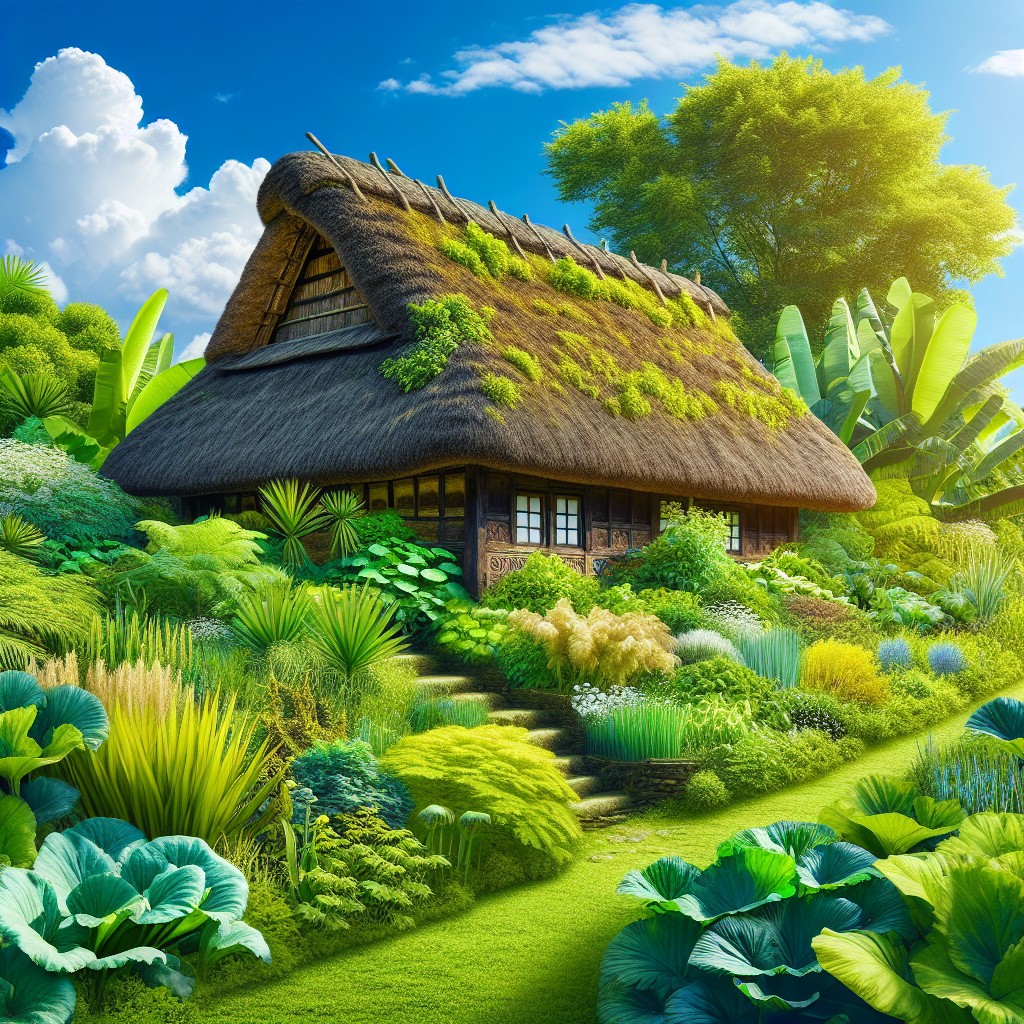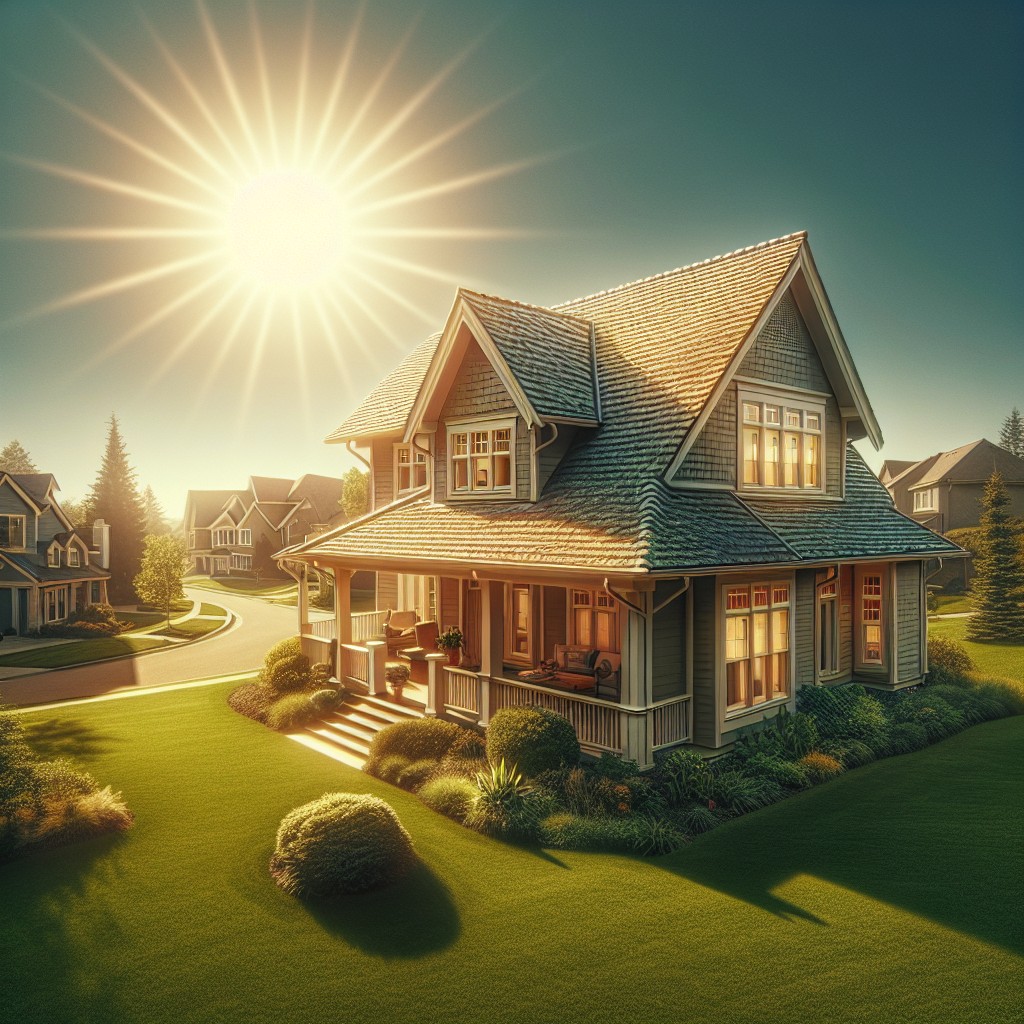Last updated on
In this article, we delve deep into the comparison of thatched roofs versus shingles because their unique qualities cater to diverse architectural needs and personal aesthetics.
Key takeaways:
- Thatched roofs: insulation, craftsmanship, maintenance, regional variations
- Shingle roofs: asphalt, wood, metal, slate options
- Thatch vs shingle material composition and variations
- Durability: thatched roofs last 40-60 years, shingles 15-50+ years
- Cost: thatched roofs more expensive initially, shingles lower upfront cost.
Definition of Thatched Roofs

Thatched roofs are a traditional roofing method that utilizes natural materials, primarily water reeds, straw, sedge, or palm fronds, which are layered to create a dense, insulative covering. This style dates back centuries and remains popular in rural areas or regions with a historical aesthetic. Its organic appearance harmonizes with natural surroundings and caters to those seeking a rustic look.
Key characteristics include:
- Insulation: Natural air pockets within thatch provide excellent thermal insulation.
- Craftsmanship: Thatching is a skilled trade, with methods passed down through generations.
- Maintenance: Regular upkeep is necessary to avoid decay and prolong roof life.
- Regional Variations: Thatching materials and styles can vary significantly depending on local practices and climate.
Definition of Shingle Roofs

Shingle roofs are a common roofing solution composed of overlapping elements, typically flat and rectangular, that create a waterproof barrier protecting the structure beneath. These elements can be made from various materials, including asphalt, wood, metal, or slate.
- Asphalt shingles are by far the most popular due to their cost-effectiveness and easy installation.
- Wood shingles offer a natural aesthetic and can last longer under optimal conditions but require more maintenance.
- Metal shingles are durable, fire-resistant, and energy-efficient, though they can be more expensive initially.
- Slate shingles provide a long lifespan and distinctive appearance, often used in high-end residential roofing.
Each shingle type adheres to the roof’s surface in overlapping layers, ensuring that water sheds effectively off the roof without leaking into the home. This roofing style is prevalent in climates with variable weather due to its adaptability and the extensive range of options it offers to suit different architectural styles and preferences.
Material Composition: Thatch Vs Shingles
Thatched roofs are traditionally crafted from natural materials such as long straw, reed, or palm leaves. These materials are layered to create a dense, waterproof barrier. The organic origin of thatch lends a unique, rustic appearance and allows the roof to blend with natural surroundings.
On the other hand, shingle roofs consist of individual overlapping elements, commonly made from wood, asphalt, metal, slate, or composite materials. Wood shingles, also known as shakes, bring a classic look, while asphalt shingles are popular for their cost-effectiveness and versatility. Slate provides a more durable and long-lasting option, with metal shingles gaining traction for their durability and energy efficiency.
Both roofing types possess distinct textures, colors, and structural nuances, stemming from their material differences. These variations not only influence the visual style but also the roof’s interaction with environmental factors such as climate and weather patterns.
Durability of Thatched Roofs Vs Shingle Roofs
Thatched roofs boast a lifespan of 40 to 60 years when well-maintained, with their natural materials often requiring professional attention to uphold their longevity.
Water reed, a common thatching material, can last up to 60 years, while straw options may need replacing every 20-30 years.
In comparison, traditional asphalt shingles offer 15 to 30 years of durability, with higher-end materials such as metal, slate, or tile shingles extending that range considerably, often up to 50 years or more.
The lifespan of shingles can also vary depending on the climate; for instance, in areas with high winds, frequent storms, or extreme temperatures, shingle roofs may require more frequent repairs or replacements.
Regular maintenance is key for both roofing types: thatched roofs must be monitored for signs of rot or animal damage, while shingle roofs benefit from regular inspections to replace damaged or missing shingles promptly.
Cost Comparison of Thatched Roofs and Shingle Roofs
In assessing the cost implications of both roofing types, it is essential to note that the initial outlay for a thatched roof is typically higher than for a shingle roof. Thatching materials, such as water reed or straw, are natural and often require specialized labor to harvest and install, which can drive up costs. Furthermore, the craftsmanship involved in thatching is a skilled trade, and finding experienced thatchers may impact the overall cost.
Conversely, shingle roofing materials, including asphalt, wood, or slate, are widely available and can often be installed by general roofing contractors. The cost of shingles tends to be lower due to their mass production and ease of installation.
Over time, maintenance expenses factor into the total cost of ownership. Thatched roofs may require periodic maintenance to keep them waterproof and extend their lifespan, potentially adding to long-term costs. Asphalt shingles, on the other hand, while lower in upfront cost, may have a shorter lifespan and can require replacement every 20 to 30 years, depending on the climate and quality of the material.
It’s also important to consider the roof’s lifespan. A well-maintained thatched roof can last 40 to 50 years, whereas higher-end shingle options, such as metal or slate, may last just as long or longer with proper care. This longevity should be weighed against the initial investment to determine the most cost-effective solution for specific circumstances.
Ultimately, the choice between a thatched roof and shingles will depend on individual budget constraints, aesthetic preference, and the value placed on traditional craftsmanship versus modern convenience.
Aesthetic Differences Between Thatch and Shingles
Thatch offers a timeless, rustic charm, evoking a sense of tradition and natural beauty. Its layered reeds or straw create a textured, organic look that seamlessly blends with rural landscapes and historical settings.
In contrast, shingles—typically made of asphalt, wood, metal, or slate—present a more uniform appearance. They come in a wide variety of colors and shapes, providing versatility for modern, colonial, or craftsman-style homes.
A key aesthetic factor to consider is how the roof will weather over time. Thatch can fade to a silver-grey, enhancing its pastoral allure, while certain shingles may develop a weathered patina that appeals to those seeking a more subdued elegance.
Each option holds its distinct visual appeal, and the choice ultimately boils down to personal taste and the architectural context of the building.
Environmental Considerations for Thatch and Shingles
Thatched roofing materials are typically comprised of natural fibers like straw, reed, or palm fronds, which are renewable resources. This makes them a more sustainable choice, as they have a lower carbon footprint compared to traditional roofing materials. Additionally, at the end of their lifespan, thatch is biodegradable, leaving minimal environmental impact.
On the other hand, shingle roofs often use asphalt, wood, or composite materials. Asphalt shingles, the most common type, are a petroleum product and therefore have a higher embodied energy—meaning the energy consumed in their production, transportation, and installation is considerable. However, some shingle materials, like wood, can be sustainably sourced or made from recycled content, which lessens their environmental impact.
Both thatched and shingle roofs have the potential for recycling or repurposing. For instance, used shingles can be repurposed for paving, and worn-out thatch may be used as garden mulch or compost.
Last but not least, the insulation properties of thatch naturally provide high energy efficiency for homes, potentially reducing the need for additional insulation materials. Shingle roofs may require extra materials to match the insulation performance of thatch, which could increase their environmental footprint.
It’s essential to evaluate the full lifecycle of roofing materials—from sourcing through disposal—to make the most environmentally responsible choice.
Installation Process for Thatched Roofs Vs Shingle Roofs
Thatched roofs require skilled craftsmanship. The process typically involves layering water reed, wheat reed, or long straw. These materials are intricately hand-fixed to the roof structure, creating a dense, ridged form that sheds water effectively. A tight overlap is crucial to prevent leaks and extend the roof’s lifespan.
In contrast, shingled roofs are more straightforward to install and don’t demand the same level of artisan skill. They start with a waterproof underlayment upon which shingles – made of asphalt, wood, metal, or slate – are nailed in an overlapping fashion from the eave upwards. This ensures water flows over each shingle without penetrating the underlayer.
The installation of a thatched roof is labor-intensive, often taking weeks, while shingle roofs can be completed within a few days, significantly influenced by the size and complexity of the roof. The necessity for specialized tools and techniques for thatching also contrasts with the more universally available resources for shingle installations.
Fire Safety: Thatched Roofs Vs Shingle Roofs
Thatched roofs, traditionally built from materials like straw or reed, present unique fire risks owing to their combustibility. To mitigate these risks, fire retardants are often applied, and modern thatching techniques can include fire-resistant barriers. Nonetheless, it’s crucial that proper maintenance and regular inspections are upheld to prevent any decay that might elevate the chance of a fire.
On the other hand, shingles, especially those made from asphalt, slate, or metal, typically offer better fire protection. These materials are usually classified according to fire resistance ratings, where Class A signifies the most fire-resistant shingles. They are designed to slow down the spread of fire, giving inhabitants more time to evacuate and firefighters more time to respond.
Despite their contrasting fire safety profiles, both thatched and shingle roofs should be paired with smoke alarms and a clear evacuation plan to ensure occupants’ safety. It’s always advisable for homeowners to consult with fire safety experts and local building codes to enhance their roofs’ fire resistance regardless of the chosen material.
Advantages and Disadvantages of a Thatched Roof Vs Shingle Roofs
Thatched roofs boast a unique charm, blending seamlessly with natural landscapes and offering high insulation properties due to their thick layers of reeds or straw. While aesthetically pleasing and eco-friendly, they require skilled craftsmen for installation and come with higher maintenance needs to prevent decay and pests.
On the flip side, shingle roofs, typically made from asphalt, wood, or slate, are widely used due to their affordability and ease of installation. They offer durability against weather elements and a straightforward replacement process for damaged shingles. However, their environmental impact is greater, and for those seeking a traditional or rustic look, shingles may not provide the desired appearance.
Deciding between the two involves weighing the initial costs against long-term maintenance, the desired look, and consideration for the environment.
FAQ
Is thatch better than shingles?
The choice between thatch and shingles depends on individual preference and needs; while thatch provides an inexpensive and more spacious option, shingles offer durability and straightforward maintenance.
Are thatched roofs allowed in the US?
Thatched roofs, although not common, are indeed allowed and seen in certain parts of the US, with their popularity growing for new homes, eco houses, and garden rooms in line with the eco home improvements trend.
How long will a thatched roof last?
A thatched roof, depending on the material, can last for up to 40+ years if comprised of water reed, or around 35 years if it’s made of combed wheat reed.
What are the overall costs associated with installing a thatched roof compared to shingles?
Thatched roofs are typically more expensive to install than shingles due to the specialized labor and longer time required for installation.
How does the insulation performance of thatch compare to shingles?
Thatch has superior insulation properties compared to shingles due to its dense composition which prevents heat transfer and maintains a consistent indoor temperature.
Can owners expect an increase in insurance premiums with a thatched roof compared to shingles?
Yes, owners can expect a significant increase in insurance premiums for thatched roofs as compared to shingle roofs due to the higher risk associated with them.
